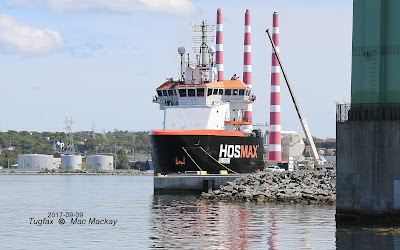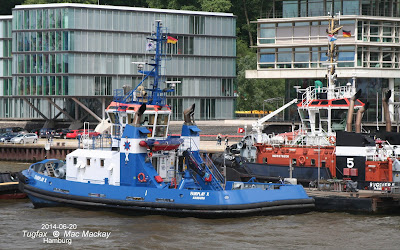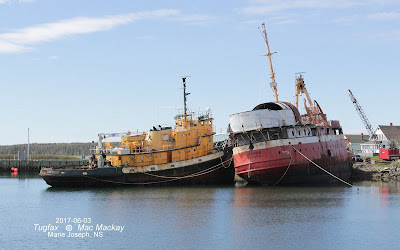See addendum at the end of this article
A major shakeup in the Quebec tug scene can be summarized as "Svitzer out / Ocean in".
Svitzer Canada, part of the multi-national tug operator, a subsidiary of the giant AP Moller-Maersk shipping conglomerate has opted to discontinue its short lived four tug Montreal operation, selling most of its local assets to Groupe Océan.
Ocean had been the sole operator in the Port of Montreal since acquiring the former McAllister business. It appears now that loyalty to Océan was strong enough that Svitzer could not gain traction.
Svitzer Montréal refitting in Halifax shortly before taking up station in Montreal in the spring of 2016. The tug was transferred from Svitzer's operation in the Dominican Republic.
When Svitzer moved in last year, it was largely on the basis of having longstanding relationships with Algoma and CSL and of course to service Maersk Lines one weekly container ship. Whether parent company Maersk's financial belt tightening was a factor or not, there apparently was not enough business to sustain the operation.
Svitzer operated its service in Montreal initially with two tugs, which did double duty, by spending the summer in the high arctic at the Baffinland iron port at Milne Inlet, serving the Mary River mine. Océan originally had the Baffinland contract, and built two 8,000 bhp super tugs,
Océan Tundra and
Océan Taiga especially for the work, which was expected to extend to year round. When the Baffinland project stalled and ArcelorMittal gained control of the project in 2011 Svitzer wound up with the tug contract. The completed
Océan Tundra found some work as an escort tug out of Quebec City, but construction of
Océan Taiga was slowed down and only completed in 2016 due to a lack of demand for the vessels.
Svitzer Nerthus and Svitzer Njal after fitting out in Halifax, are almost ready to sail for their first season at Milne Inlet.
Svitzer Njal and
Svitzer Nerthus were brought back to Canada by Svitzer in 2016, but at 5,000 bhp, they would only be able to work seasonally in the far north (July - October). As ice class tugs however, they are quite suitable for year round work in Montreal. They will be fulfilling the Baffinland contract this summer too, but at the end of the season they will become Océan tugs.
Baffinland had originally planned a year round rail line operating to a port on Steensby Inlet, which would be accessible to larger ships and presumably require larger tugs for year round service. It now seems they will build the rail line to Milne River instead, replacing the present 100km tote road for trucks. This will allow the mine to reach its 12 mn tonnes per year shipping target. They also plan to bring in ships of up to capesize, which will also require larger tugs.
Of the four Montreal based tugs, only Svitzer Cartier was not built by Eastisle Shipyard in Georgetown, PE. The Chinese built tug is the only Voith-Schneider tug in the lot.
Svitzer acquired two more tugs for Quebec work.
Svitzer Cartier, a Chinese built V-S tug initially arrived to provide additional tug service for Port-Cartier, where ArcelorMittal has a major iron ore and grain port, and two aging V-S tugs of its own.
Svitzer Cartier apparently did not work out well at Port-Cartier and was transferred to Montreal.
Its fate is unknown at this time, but may be acquired by Océan. (see Addendum)
Océan has now also acquired the tug contract for Port-Cartier and will be moving two of its tugs there later in the year, replacing the ArcelorMittal owned tugs
Brochu and
Vachon. V-S tugs, they were adept at working in the tight confines of Port-Cartier, but Océan has no V-S tugs of comparable power, so it will interesting to know what tugs they will be using. They will have several tugs coming back from Newfoundland now that the Hebron gravity base project is complete.
Earlier this year Océan was awarded the operating contract for the V-S tug
Pointe-Comeau, based in Baie-Comeau, and owned by Cargill Grain. The tug was under Svitzer (and previously Eastern Canada Towing) management since it was built in 1977. In fact predecessor copmay Foundation Maritime managed the Cargill owned
Foundation Vibert from when it was built in 1961. It became
Point Vibert under ECTUG management until replaced by
Pointe-Comeau.
The fourth Montreal tug,
Svitzer Montreal (ex Caucedo) at 4500 bhp ASD
will be sold to Océan and could be used in any one of several ports served by Océan. Three of the four tugs should be a good fit in the Océan stable, since they were built by Eastisle in Georgetown, PE to the same basic design as eight of Océan's tugs.
(see Addendum)
Océan now has a tight lock on all St.Lawrence River ports, as the exclusive tug operator with tugs based in Sept-Iles, Port Cartier, Baie-Comeau, Quebec City, Trois-Rivières, Sorel and Montreal.
(In 2012 Océan won the Iron Ore Company of Canada contract at Sept-Iles held by Svitzer and predecessors since the 1950s. It also bought ECTUG's two Sept-Iles icebreaking tugs.)
Océan also operates tugs on the Great Lakes to serve Hamilton, Toronto and Oshawa and a small tug in the port of Goderich.
Business prospects for the port of Montreal in particular appear to be on the upswing, as the port shows increased container and tanker traffic. The St.Lawrence River can now accommodate much larger ships. although draft restriction still apply.
Svitzer is now reduced back to three tugs at Point Tupper, NS:
Point Chebucto,
Point Valiant and
Svitzer Bedford. The rather surprising move to Montreal was a bit unusual for Svitzer, a company noted for negotiating long term terminal contracts, rather than speculative ventures into unknown territory.
.
Addenda:
Since posting this blog more information has come to light.
1. Océan is not acquiring
Svitzer Montréal The tug is not ice rated (it was built for the Dominican Republic) and thus will be re-assigned by Svitzer.
2. Océan has indeed acquired the
Svitzer Cartier and will be sending it to Ile-aux-Coudres for refit by Industrie Océan. This leads me to assume that it will assigned to Port-Cartier. At 5400 bhp it would certainly provide more power than the two 3600 bhp tugs in place there.
3.Océan will be supporting the Port-Cartier contract with two V-S tugs. Unknown at present what those tugs will be, however:
Océan has one other V-S tug:
Océan A. Simard ex Alexis Simard, 3290 bhp. It has been working on the Hebron project in Newfoundland, and seems a likely candidate for Port-Cartier.
At present
Océan Arctique is supplementing the two ArcelorMittal tugs in Port-Cartier and will presumably remain there.
.



















































